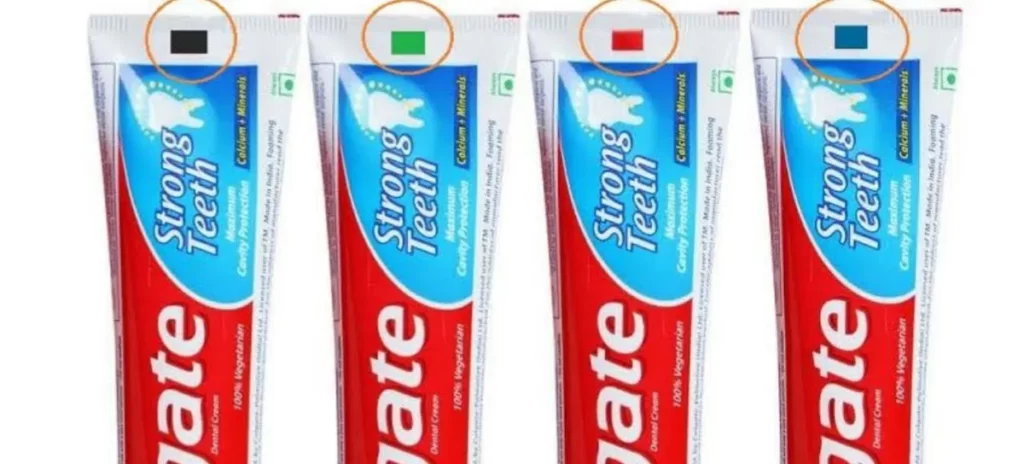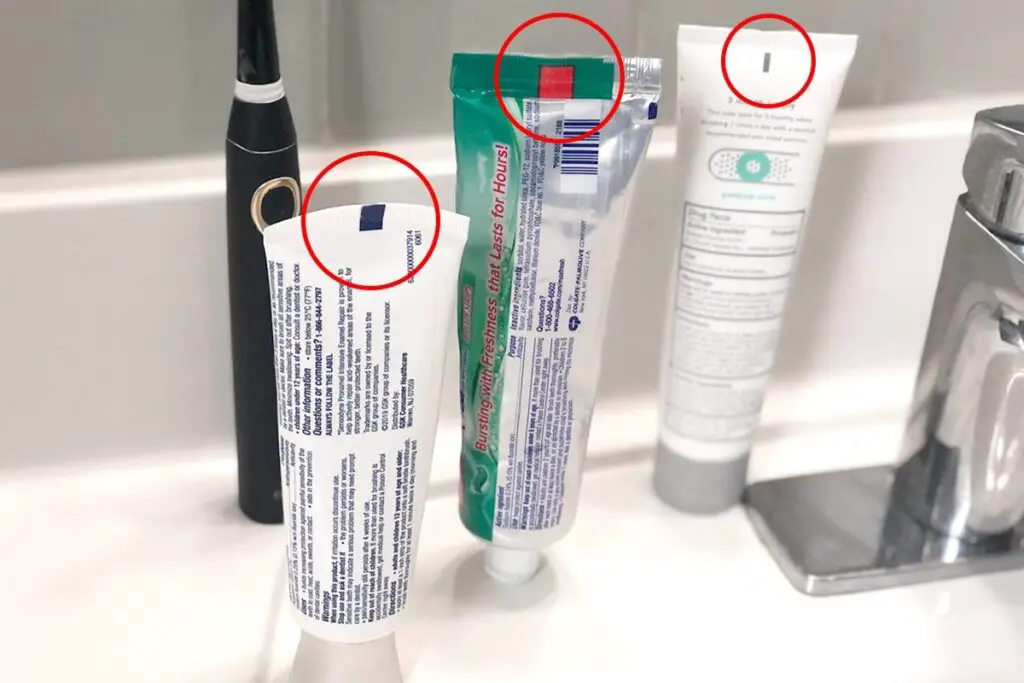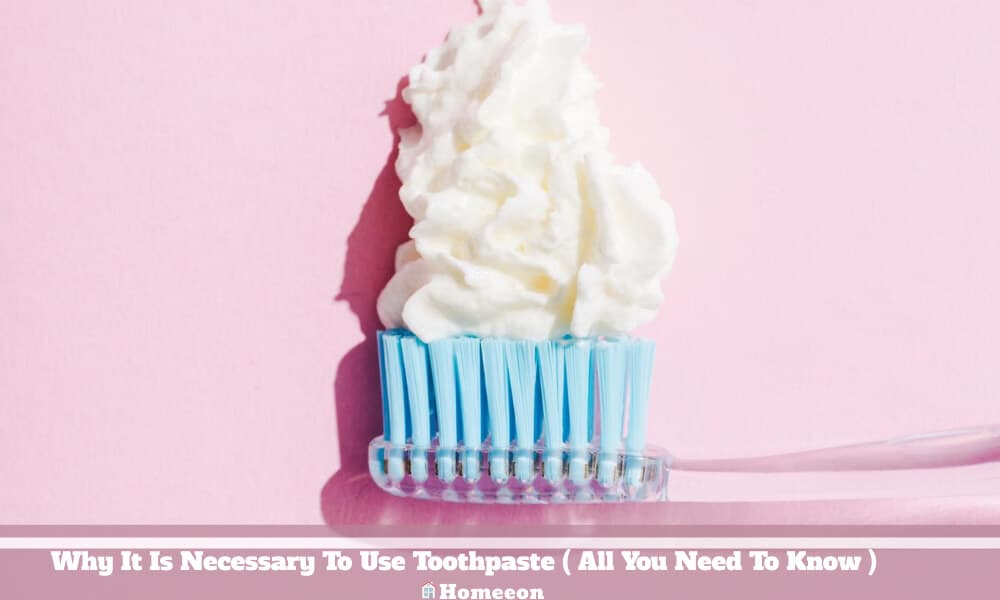Last Updated on August 3, 2023 By Emma W. Thomas
Color codes on toothpaste tubes are used by some manufacturers to indicate the type of toothpaste or its specific features. For example, green might represent natural ingredients, blue for whitening, red for sensitivity, etc. Always read the label for accurate information about the toothpaste’s properties.
Meaning of Toothpaste Colors
| Toothpaste Color | Meaning |
|---|---|
| Green | This color often represents a toothpaste made with all natural ingredients. It may also include special herbs or plant extracts that are beneficial for oral health. |
| Blue | Blue typically indicates a toothpaste that contains additional elements for fresh breath, such as mint or cool sensations. |
| Red | Red-streaked toothpaste often suggests ingredients that support gum health, although this is not a standard industry-wide. |
| White | Pure white toothpaste usually means that it is a basic toothpaste, without any special added ingredients or features. |
What Do Toothpaste Color Codes Supposedly Mean?

Color code markings on toothpaste tubes have been falsely associated with ingredients used in toothpaste. They are usually some normal small squares at the bottom of the tube.
Colors vary depending on the manufacturing companies. Allegedly, the green mark indicates that all ingredients used are natural. Blue markings indicate the use of natural and medicinal ingredients in toothpaste.
Those with red markings indicate that the ingredients used are a combination of chemical and natural ones. Black-labeled toothpaste is allegedly made of pure chemicals. Consumers are even discouraged from using toothpaste with black codes claiming they are dangerous to their health. The only way of identifying safe toothpaste is by checking the presence of ADA seal of acceptance by the American Dental Association.
These colors have no connection with the ingredients used in toothpaste. They are just marks made during manufacturing to be read by light beam sensors. Their purpose is to notify manufacturing machines where to cut, fold, and seal. They also come in more than just the four colors since different manufacturing companies have different sensors. The bottom line is; all colors mean the same thing. To know the ingredients used in toothpaste, consumers should consider reading the packaging, which contains all the necessary information. It even includes flavors and the expiry date of toothpaste. This is better than anticipating ingredients by judging from a mere color code.
What Are The Ingredients Used In Toothpaste?
The claim of color codes on toothpaste is a fake consumer tip. All tubes of toothpaste have the used ingredients on their packaging. Comparing those ingredients with the information about color codes proves how false this information is. Most commonly used ingredients include:
Humectants
Humectants are materials used to prevent toothpaste from hardening after opening and exposing them to room temperature. The most commonly used humectants are glycerol, xylitol, and sorbitol.
Solid Abrasives
Abrasives are used in toothpaste to help remove food particles from teeth. They also help polish teeth due to their abrasive nature. The most commonly used abrasives in toothpaste are calcium carbonate and silica.
Binding Materials
These substances are used to prevent toothpaste ingredients from separating by stabilizing them. It is also known as a thickening agent. Some thickening agents used in toothpaste are carboxymethyl cellulose, carrageenan, and xanthan gum. They enable toothpaste to maintain its thickness and form.
Sweeteners
Most toothpaste companies use sweeteners that do not affect teeth to prevent causing cavities. Some of these sweeteners are sodium saccharin, and acesulfame K. Consumers should look out for sweeteners used as some are considered cancerous.
Flavors
Most consumers use flavors to choose the toothpaste to use. Most flavors do not contain any sugars. Some of the flavors commonly used are spearmint, peppermint, cinnamon, anise, and bubblegum. Flavors help to enhance oral breath.
A Surfactant
This ingredient is used to help in foam formation and emulsify the flavors used. Examples of surfactants include sodium lauryl sulfate and sodium N-lauryl sarcosinate. They also make toothbrushes move with ease in the mouth.
Fluoride
Flouride helps in strengthening the enamel and prevent cavities. It is naturally occurring and is mostly labeled as sodium fluoride, stannous fluoride, or mono-fluoro sulfate in most toothpaste.
The above ingredients are the most commonly used components in toothpaste. It is advisable to get toothpaste with an American Dental Association(ADA) seal. Such kinds of toothpaste are proven to be effective and safe for consumers’ health through testing.
Types Of Toothpaste Depending On The Ingredients Used.
Some kinds of toothpaste contain special ingredients that serve special purposes. There are different types of toothpaste, which are:
Whitening Toothpaste
Whitening toothpaste contains stain-removing agents and a whitening effect. They achieve this by adding calcium peroxide or hydrogen peroxide to the toothpaste.
Sensitive Teeth Toothpaste
This type of toothpaste is created for people with sensitive teeth. For example, individuals who experience very sharp pain when they take hot or cold foods. Such toothpaste contains a desensitizing agent, for example, potassium nitrate or strontium chloride.
Kids Toothpaste
Toothpaste made for kids contains less fluoride to prevent the risk of ingestion since they are likely to swallow toothpaste while brushing their teeth. Using excess fluoride can also cause damage to the kids’ enamel leading to a dental problem known as dental fluorosis.
Fluoride-Free Toothpaste
Some consumers prefer to go for fluoride-free toothpaste despite the knowledge of its importance. Such toothpaste only cleans the teeth but fails to offer protection from decay and cavities.
Natural Toothpaste
Some companies create natural toothpaste by using natural and herbal ingredients. They achieve this by using baking soda, aloe, activated charcoal, plant extracts, and other essential oils. These are mostly used by people who prefer to go all-way natural.
When choosing a toothpaste, features such as ADA seal of acceptance, ingredients used, expiry date, and flavor should be top-notch. Other things such as color codes are but consumer tips.
When To Use Natural Toothpaste
Some people prefer to use natural toothpaste just because they want to. It may not be the case for others since they lack options. For instance, if one experiences unexplained canker sores, it may result from the type of toothpaste used. Chemicals foaming detergents and parabens irritate some people. For this reason, one should consider using natural toothpaste. Other than just the sores, the chemicals are harmless since one does not swallow toothpaste.
In other cases, some people tend to experience sensitivity while brushing. One should avoid using toothpaste that contains sodium lauryl sulfate(SLS) as they irritate mouth tissues in such situations. It is also advisable to avoid using toothpaste with saccharin sweeteners and other artificial sweeteners as some may be carcinogenic.
Natural Toothpaste Ingredients You Need To Look For
As much as some people want to use natural kinds of toothpaste, it is advisable to avoid charcoal. The reason is, charcoal can be extra abrasive to one’s teeth, causing extra scratches. These scratchings may remove the topmost layer of the teeth, leaving them exposed. Such conditions welcome effects such as tooth sensitivity, which may require medical attention. One cannot avoid fluoride completely. It is important to consider using it at least once a day due to its proven ability to prevent cavities. For example, one could skip using fluoride toothpaste in the morning and use one at night to avoid opening up cavities.
One can keep an eye out for some natural ingredients such as aloe Vera, which is widely known to prevent gum infections. Coconut oil, salt, and tea are also alternatives to natural toothpaste ingredients. Baking soda is among the most used natural ingredient for teeth whitening.
Why It Is Necessary To Use Toothpaste

Some people ask why they need toothpaste when they can easily remove food debris from their teeth without using it. The answer to this is obvious. People brush their teeth to create a fresh feeling in their mouths. Toothpaste provides this taste from different flavors used, creating pleasure in one’s mouth.
Some sticky substances cannot be removed by just brushing without toothpaste, such as dental plaque. These are sticky, colorless biofilms of acidic bacteria and can easily break down a tooth enamel exposing it to cavities. Plaques can also cause gum irritation, which causes gingivitis. One needs to use toothpaste as it has abrasive ingredients to eliminate such plaques. Failure to use toothpaste will limit one from eating sugary foods and drinks.
Other reasons to use toothpaste other than to control plaque and cavities are; toothpaste generally tastes good, like mint, which is the most common flavor in the US. There are other flavors such as banana, bubble gum, eggplant, honey, lemon, and peach. These flavors keep one on toes motivating one to maintain oral health. Fluoride does not only keep away cavities but also strengthens one’s teeth enamel. For this reason, people prefer to use toothpaste.
Additionally, toothpaste helps one address other teeth issues such as teeth whitening, sensitivity and tooth decay and other gums issues. It is important to use a pea-sized drop of toothpaste, unlike the huge stripes shown during commercials.
Conclusion
People should completely ignore information from the internet about color codes on tubes of toothpaste. They have no absolute meaning, especially about the contents of toothpaste. Those markings come in different colors and are not limited to only blue, black, red, and green. They are barcodes made by sensor machines during manufacturing, and different companies have their preferred colors.
Consumers who want to know the ingredients used in toothpaste should read the toothpaste box, which provides a full list of ingredients. One should consider looking at the expiry date, flavor, and whether a product has a seal of acceptance from the ADA.
References:
https://silverhilldental.com/toothpaste-color-codes-mean/
https://www.colgate.com/en-us/oral-health/selecting-dental-products/what-is-a-toothpaste-color-code
Emma is a graduate of Domestic Science or Family and Consumer Sciences (Home Economics) from the University of Wisconsin. She has 7 years of experience Working with the strategic section of BestBuy and now writing full-time for Homeeon.
From Managing the Home, Interiors, Cleaning, and Exteriors to Gardening and everything about Making A Home Liveable – is her passion and this Homeeon is the result of this.
Emma loves decorating her home with the best stuff found online. She cares about quality over anything and writes reviews about them here in Homeeon. Get in touch with her over Pinterest.
Keep reading her blogs.

